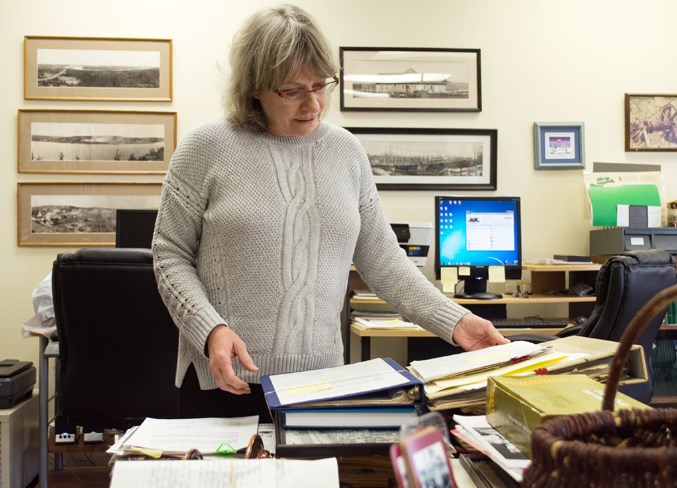Tucked away in a corner behind the Old Brick School, Margaret Anderson is settling into a new role that entails her carrying the fonds once held by the likes of Eileen Hendy, Marilyn Mol and Gina Payzant.
On Oct. 4, Anderson became Athabasca’s newest archivist.
In the process of transitioning to retirement from her job at Athabasca University, Anderson said she did not want to stop working.
“I guess I could say I’m overwhelmed, but I’m not really,” she said. “I understand there’s a lot of work to do here, and I’m really thrilled to be here.”
She said applying for the archives job seemed like a good idea for her, adding that she feels it is important to support it.
“I’ve been coming in this building for years, just doing research,” she said. “It’s just a great little institution we have here. I feel very strongly about supporting it.”
Upcoming projects
Anderson said one of her goals will be updating Alberta On Record’s information about the Athabasca Archives’ fonds — folders that hold printed historical information on a particular topic.
“The immediate goal is to get our information current with Alberta On Record, the Archives Society of Alberta,” she said. “Alberta On Record pulls together institutions like Glenbow and PAA as well as the Westlock Tractor Museum and the Athabasca Archives, so it’s a provincial entity. Kind of a one-stop place where you can go and search for things, and limit or expand your search.”
She said she is also looking to digitize the archives in some way.
“I’m really curious what a digital archive would be,” she said.
“I think we’re agreed that paper copies of things are the most permanent, in the sense that they don’t change,” Anderson said. “They just sit in a binder or in a file folder, and wait for you to come and pull them and read the information or look at the photograph.”
She noted that it is also important to back the solid content up, as well. She pointed out that the format of digital information changes all the time, citing beta tapes versus VHS tapes as an example.
“It’s a really interesting question — what form would a digital archive take, and is there a way to make it slightly more permanent than every five years?” she said.
She gave a nod to Linda Doroshenko, noting that she has done a lot of work scanning photographs and associating keywords and a description with each.
“The current rough count is 20,000 photographs here at the archives,” Anderson said, noting that the virtual copies are online.
Anderson, who started working as a graphic artist with Athabasca University in 1986, said she has volunteered with the Athabasca Heritage Society for about eight years, and chaired it since 2012.
She said the year she started at the university, Athabasca Landing: An Illustrated History was published. The book has a note on its first page, that it was a “75th anniversary project by the Athabasca Historical Society, David Gregory and Athabasca University.”
Anderson said this was her first exposure to the Athabasca Archives, and just how valuable they are. She also said her research and study leave project this past summer was making a digital copy of the book.
She said she thinks it is really worthwhile to be a part of the archives, and she really likes the community as well.
“I know that really intriguing, interesting information is going to come out of this journey,” she said. “Personal to me, kind of thing. I don’t know what it will be.”



